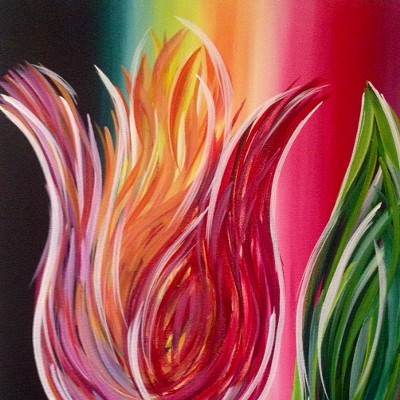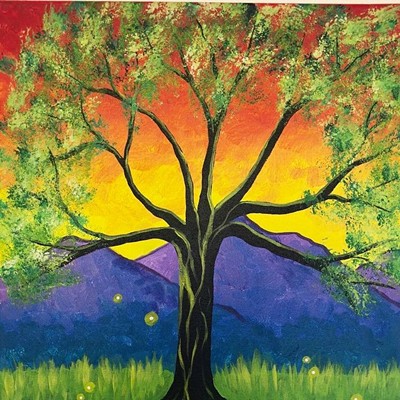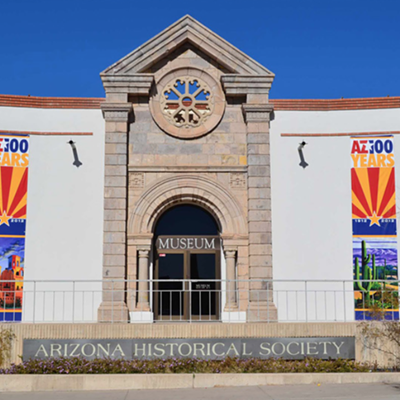Dapper in a pure white suit that matched his carefully combed white hair and moustache, the artist was wearing a startling tie, a Palm Beach concoction in peach and green art deco curves. He said the tie has a special meaning for him: It was the same one he wore nearly 60 years ago, "the day I volunteered for the Navy in 1943."
It's an understatement to say that Anderson, 77, relishes old things, and holds onto them. Plenty of old friends had gathered around to celebrate the opening of Warren H. Anderson: A Retro Retrospective. Competing to get a word in with the artist were neighbors of the Foothills house he's lived in for 31 years, two of his doctors and dozens of his ex-students from the University of Arizona, from which he retired 16 years ago.
"Some of my former students are here--they're now older than I am," he joked. "It's been a reunion."
The people weren't the only relics of his past on hand. On the gallery walls hung his art, inspired by vanished roadside Americana. Anderson's meticulous colored pencil drawings memorialize the vernacular road signs that are now almost extinct in a nation littered with homogenized Golden Arches. The artist used to roam the highways that ruled before the days of the interstates, and with pencil and paper he recorded neon signs in the curvy shapes of pinup girls, great billowing gas pumps and elegantly lettered hotel and motel signs. Anderson rendered these treasures carefully in intricate drawings that mimic the look of antique linen postcards, their colors as faded as the era they capture.
"I don't understand much after 1950," Anderson explained, raising an eyebrow. "Before then it was an era of unique style; not everything was the same. The era of great design lasted into the '50s, to be charitable. It was historically, aesthetically and socially more gratifying than what we see today."
Gratifying is right. The small businesses along Route 66 or 80 lured drivers in for a meal or a cheap sleep in a roadside cabin with quirky signs full of puns and down-home exuberance. Who could resist a slice of apple pie at a café clever enough to usurp the legend of William Tell? Anderson's piece "William's Last Arrow" honors the unknown artisan who came up with the idea. At the sign's center is a fat red apple, labeled Café/Pies. But piercing this fine fruit is a huge arrow, and tumbling down the arrow's shaft are the words "Bill Tell." Elsewhere, a tavern sign erupts in a geyser of neon beer bubbling over a tall glass, and in still another piece, a Ronald Reagan look-alike in tin, swings a lasso against a western landscape.
"These highways became redundant," he said sadly. "The old sculptural gas pumps and neon signs are all homogenized now."
The self-described "road scholar" always fully subscribed to the romance of the American road. "The night I turned 16 I bought a car," he says, and that car spawned a long series of successors, most of them the small, practical vehicles of a family man and teacher on a tight budget. (His most recent is a fancy Lincoln Continental, but health problems prevent him from driving it.) After he took the job at the UA, he and his wife, Audrey, routinely indulged in the classic American road trip, bundling their three kids up in the back seat and journeying back to Illinois to see his family. The back roads and the ghost towns they saw en route eventually made their way into his art.
It was a map that got him started on the project that made his reputation.
"In 1975 I was down in Douglas, photographing old towns and Main Streets, and I found a map behind the Gadsden Hotel showing U.S. 80 from San Diego to Savannah, Ga. I said, 'I'm gonna follow that line.'"
He submitted a sabbatical proposal for his plan to document the old highway (which in Tucson goes by the name of Benson Highway), and soon set off. Whenever he saw a piece of highway artistry, he'd stop and photograph it, and make sketches. More often than not, a big-rig truck would pull up and block his view, or a sudden rainstorm would intervene. "But art," Anderson said, "is problem-solving."
Back home in the studio, he put in a month or two on each of the intricate final drawings. Fifty-seven of the pictures made their way into a book, Vanishing Roadside America, published in 1981 by the UA Press but now out of print, and into numerous museum exhibitions and collections. (The major Arizona museums own some of his work, and so does the Hirshhorn in Washington.) They even took a star turn on television in a PBS documentary.
In more recent years, Anderson, traveling less, has switched to pictures of imaginary roadside Americana, and what he calls "floated montages." These assemblages are made up of found objects--particularly vintage postcards and photos--and his own drawings.
"All of them have an affinity toward another era," he said, "filled with the objects that have survived. They're metaphors for people's daily lives. People held these objects, and the objects take on a life of their own. I feel a great kinship with them."














